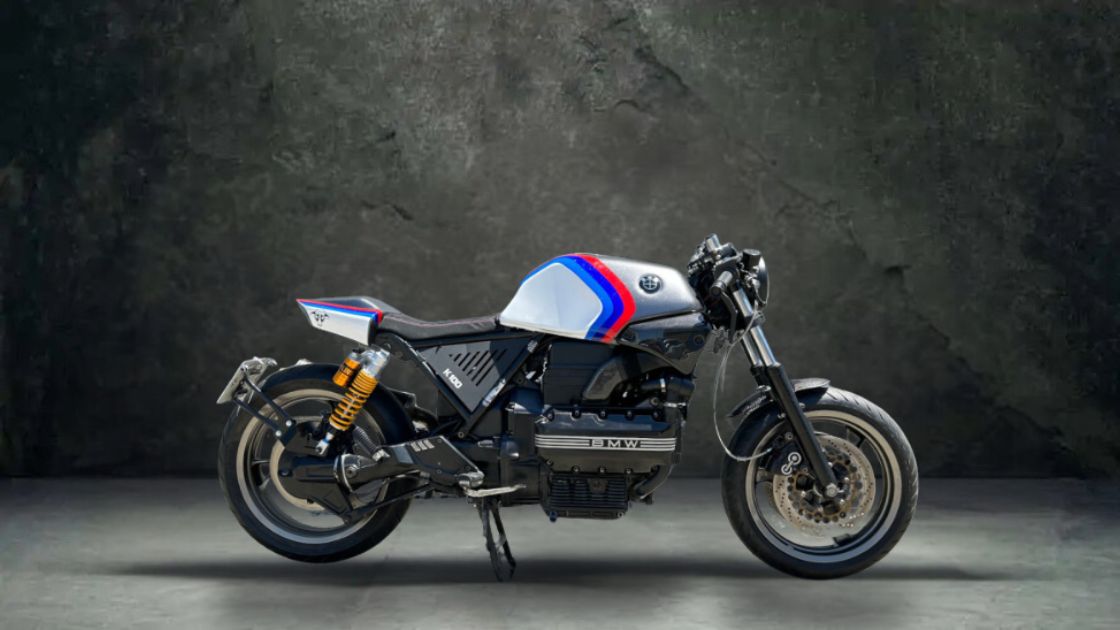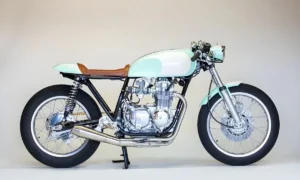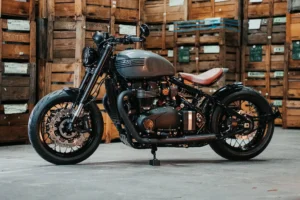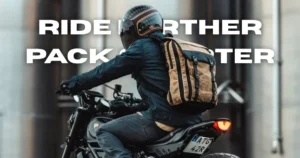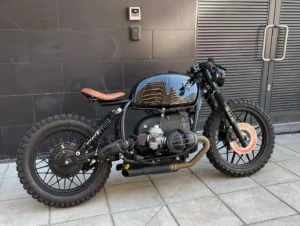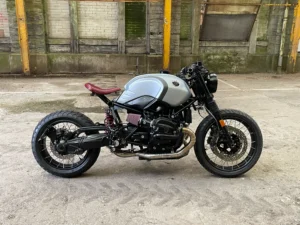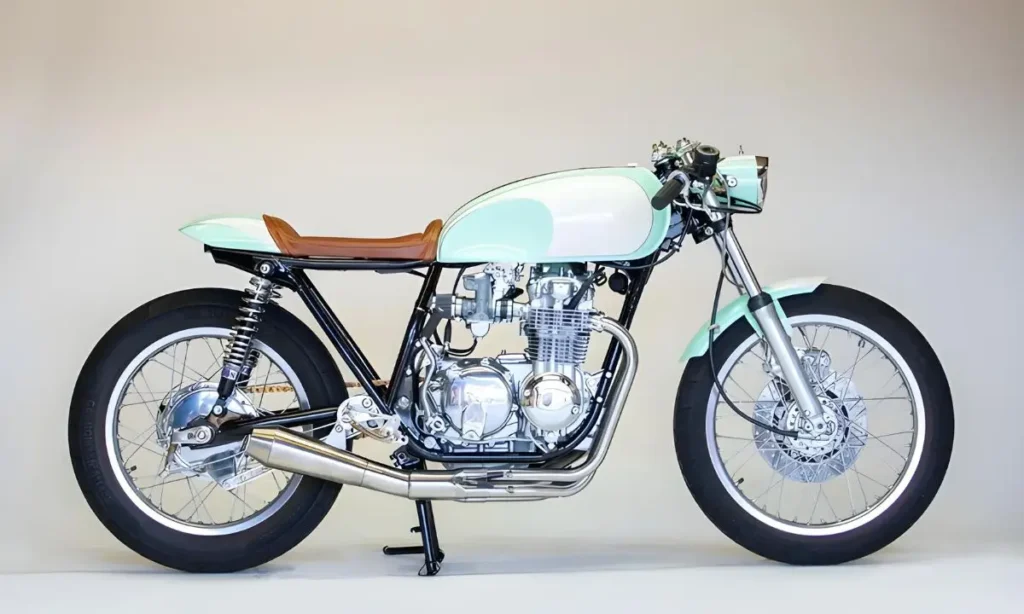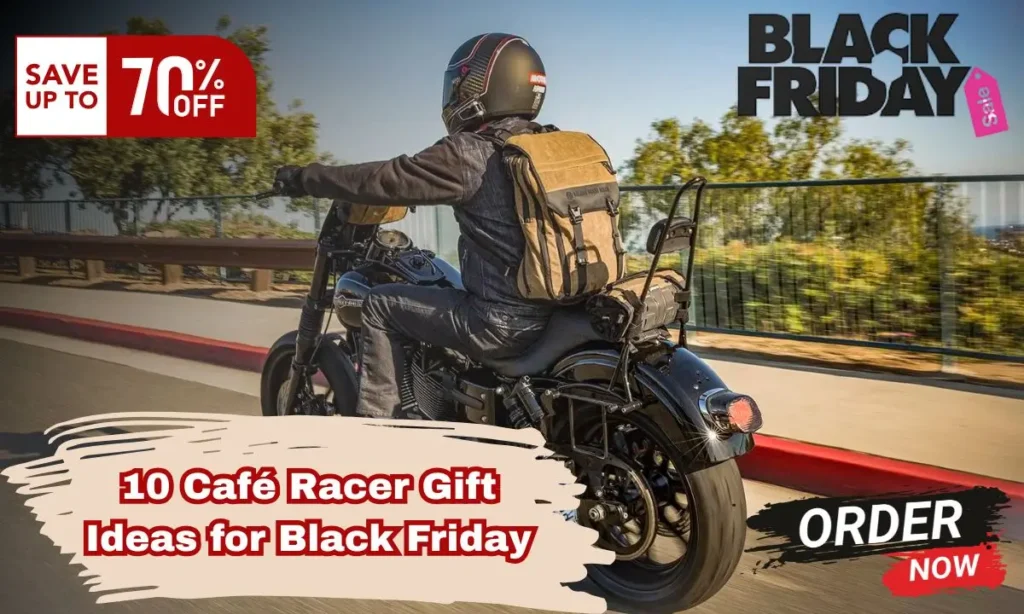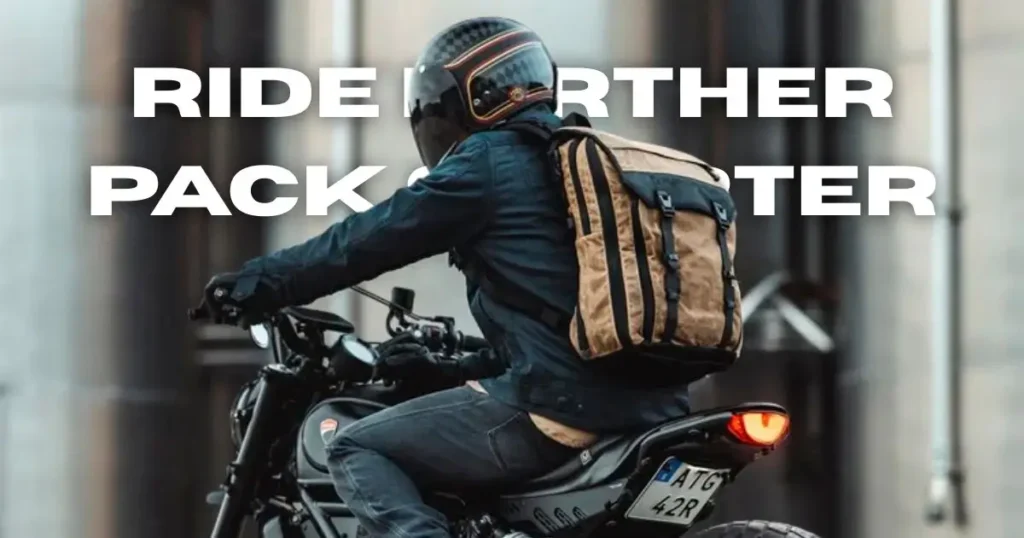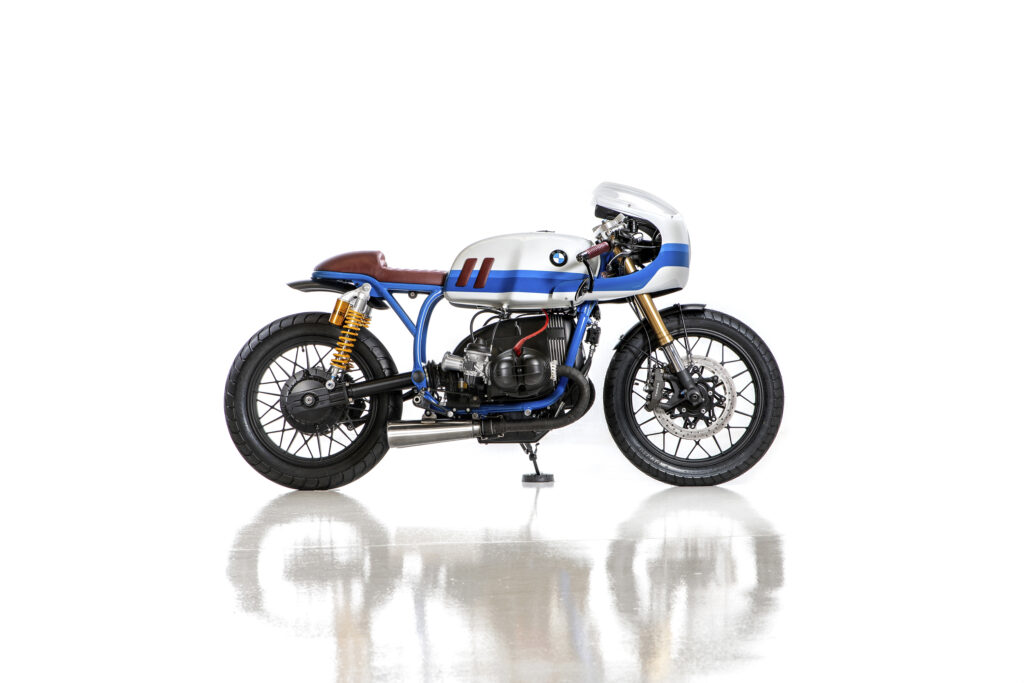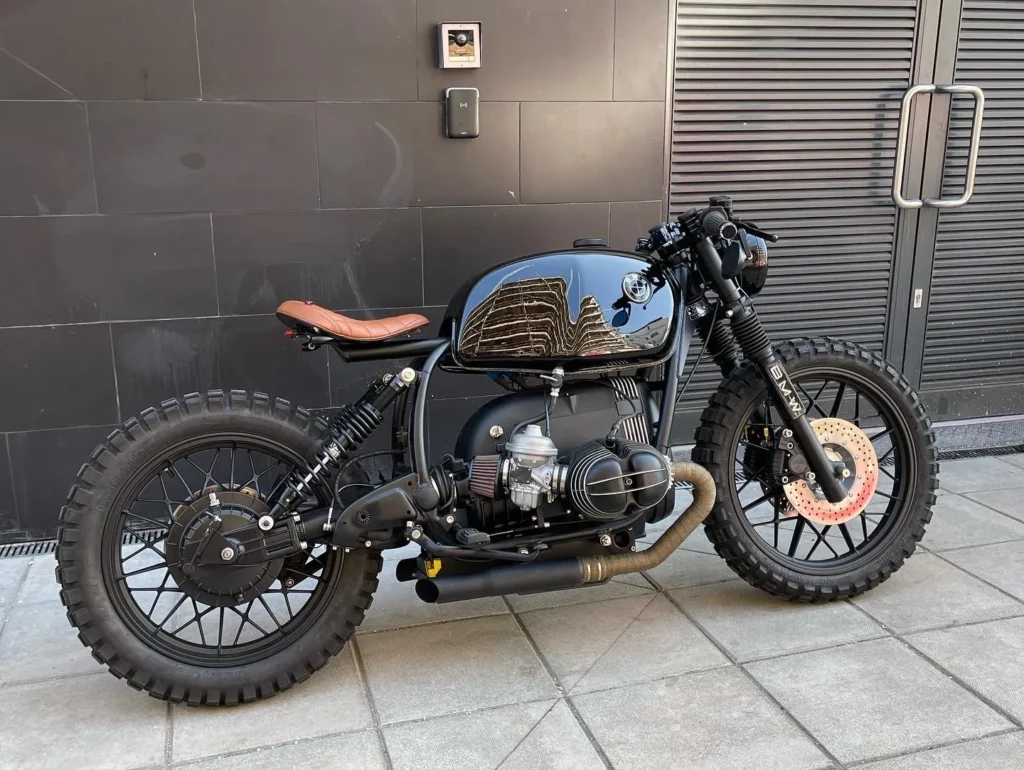Table of Contents
ToggleDiscover the excitement of the BMW K100 Cafe Racer, a bike that’s both a classic and a custom favorite. This legendary motorcycle, built with smart design and a passion for speed, has been loved by riders for years. It started as a touring bike but has become a fast, sleek racer. The K100 Cafe Racer shows how anyone can customize a bike.
This easy guide takes you through the BMW K100’s history. You’ll learn about its key moments and how it became part of the cafe racer scene. We’ll show you the special features that make it powerful, and how you can modify it to create your own unique ride. Whether you’re a pro at building bikes or just love cafe racers, this guide will teach you all you need to know about the exciting world of BMW K100 Cafe Racers.
Development History
BMW made the K100 motorcycle in 1983. It was very different from their other bikes. BMW wanted to compete with Japanese companies, so they made the K100. It had a new engine design with parts like BMW cars. This engine was stronger and used less gas. The K100 wasn’t meant to be special, but people liked its look. They started to change it to make it their own. The engine got the nickname “Flying Brick,” which made the bike even more popular.

Key Milestones
- 1983: BMW made a new motorcycle, the K100, that is very different from the usual ones.
- 1985: They make a new kind of K100, the RT. It’s better for long trips with a bigger windshield and storage boxes.
- 1988: BMW makes a new fast K1 motorcycle based on the K100.
- 1990s: The K100 gains popularity among custom builders, with cafe racer conversions becoming common.
- 2000s-Present: The K100 cafe racer is still liked for custom motorcycles. It has a special design and a strong engine.
How Did the BMW K100 Evolve into a Cafe Racer?
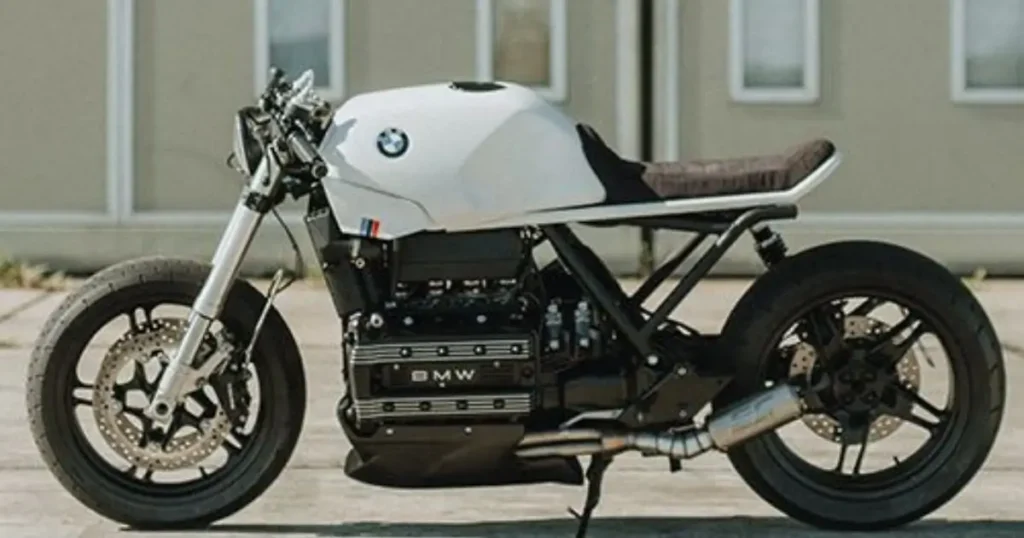
The K100 cafe racer became popular because people wanted faster, cooler bikes. The K100 was a great base for changes. It had a strong engine and good suspension. People changed the K100 by adding new handlebars, footrests, and seats to turn it into a cafe racer. They also made the engine stronger and changed the exhaust to make it louder. This created a new cafe racer that looked old but had modern parts. People loved it because it was unique and fun to ride. The K100 cafe racer is still famous today. People love its strong engine, unique look, and exciting history. It’s a bike that will always be remembered.
BMW K100 Specifications
Engine Specifications:
- Engine type: Liquid-cooled, inline-four cylinder
- Displacement: 987cc
- Bore x Stroke: 67.0 x 70.0mm
- Compression ratio: 10.2:1 (later models 11:1)
- Valvetrain: 8 valves (2 per cylinder) or 16 valves (4 per cylinder in later models)
- Fuel system: Bosch LE-Jetronic fuel injection
- Power: 90 hp (67 kW) at 8,000 rpm (early models), 95 hp (71 kW) at 7,500 rpm (later models)
- Torque: 86 Nm (63 lb-ft) at 6,000 rpm (early models), 85 Nm (63 lb-ft) at 6,000 rpm (later models)
- Transmission: 5-speed
- Final drive: Shaft
Frame and Design:
- Frame type: Tubular steel
- Front suspension: 41.3 mm Fichtel & Sachs telescopic fork (early models) or 41 mm Showa telescopic fork (later models)
- Rear suspension: BMW Paralever single-sided swingarm with mono shock
- Front brakes: Dual 285 mm discs with Brembo two-piston calipers
- Rear brake: Single 285 mm disc with Brembo single-piston caliper
- Wheels: 17-inch cast aluminum (early models) or 18-inch (later models)
- Tires: Front: 100/90-18, Rear: 130/80-17 (early models) or 120/70 ZR17 (front) and 150/70 ZR17 (rear) (later models)
Performance Details:
- Top speed: Approximately 220 km/h (137 mph)
- 0-100 km/h (0-62 mph): Approximately 4.5 seconds
- Fuel consumption: 6.1 l/100km (38.3 mpg) on average
- Fuel tank capacity: 22 liters (5.8 gallons)
BMW K100 Cafe Racer Customization
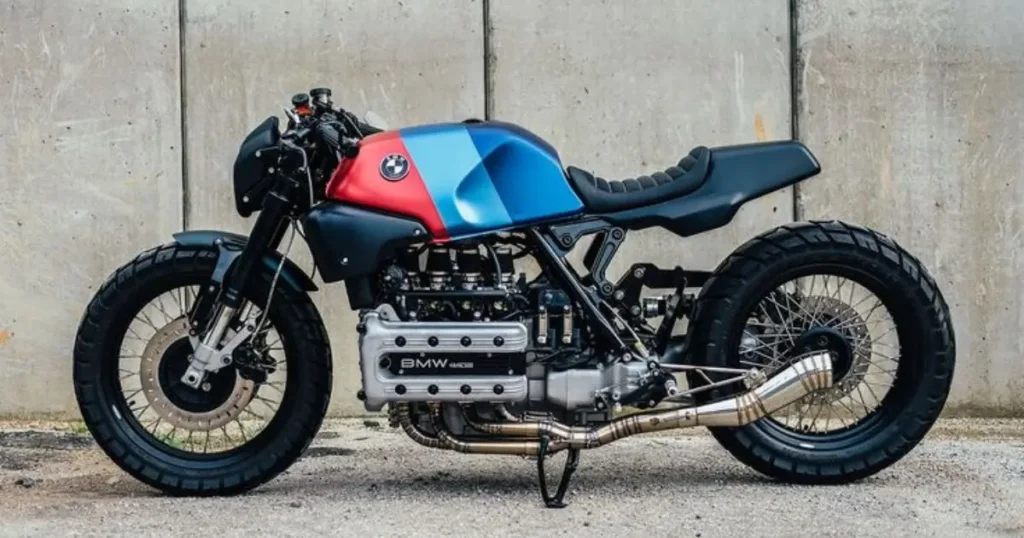
Design Philosophy:
The K100 Cafe Racer combines classic cafe racer style with a unique look. The goal is to remove extra parts to make the bike look and ride better. These design features are common in a K100 Cafe Racer:
- Minimalist Bodywork: Removed fairings, fenders, and unnecessary panels.
- Custom Seat: A sleek, single or two-up seat with a cafe racer hump.
- Clip-on Handlebars: Lowered handlebars are used for aggressive riding positions.
- Rear-set Footpegs: Relocated footpegs for improved cornering clearance.
- Exposed Engine: Highlighting the iconic “Flying Brick” engine.
- Custom Paint: Often featuring classic cafe racer colors and designs.
- Performance Upgrades: Upgraded suspension, brakes, and exhaust for improved performance.
What is a Cafe Racer?
Cafe racers are motorcycles that first appeared in England in the 1960s. Young riders changed their bikes to go faster and handle better. They would race between cafes. These bikes had only the basics. They had low handlebars, moved-back footpegs, and little bodywork. Cafe racers were a sign of rebellion. Their style still inspires people today.
Historical Context:
The K100 cafe racer became popular in the 1990s because people liked the cafe racer style. The K100 had a cool look and a strong engine, making it easy to customize. Its special “Flying Brick” engine made it stand out.
The K100 cafe racer shows how the cafe racer style still appeals to people. This bike mixes classic looks with modern technology. It is fast, stylish, and timeless.
What are the Popular Modifications for a K100 Cafe Racer?
- Front End Swap: Switching to better forks and brakes to improve the bike handle and stop.
- Subframe Modification: Making a special subframe to fit a cafe racer-style seat.
- Exhaust Upgrades: Adding custom exhausts for better sound and performance.
- Lighting Modifications: Adding LED lighting and custom turn signals for a modern look.
- Electronic Upgrades: Installing new gadgets and electronics for better functions.
You can do a lot to customize a K100 cafe racer, making it reflect your style and likes.
What Are the Key Customization Areas for Transforming a BMW Cafe Racer?
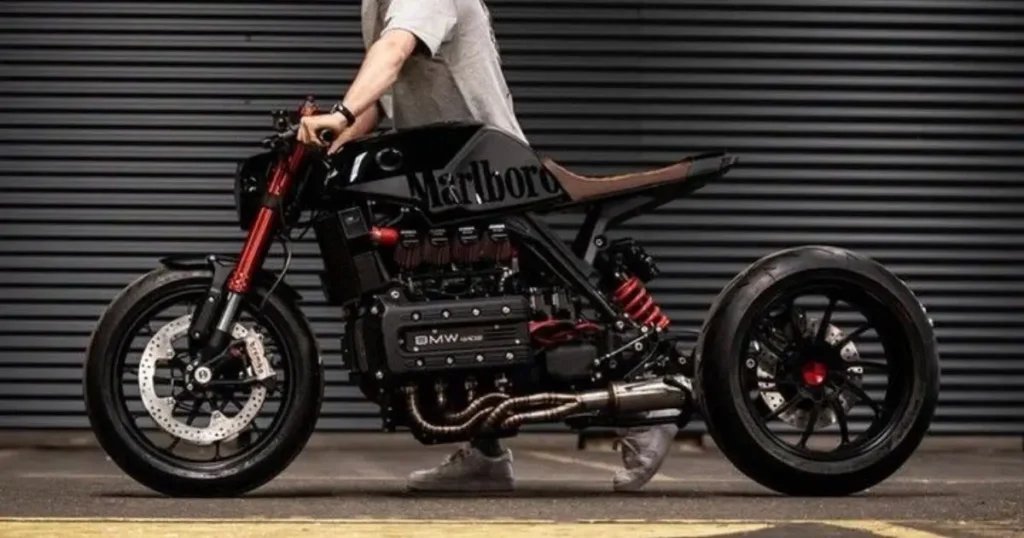
Transforming a BMW K100 into a cafe racer involves focusing on several key areas of customization:
- Bodywork:
- Seat: A slim, single-seater cafe racer-style seat is a must. You can choose from custom-made options or modify the existing seat.
- Tail Section: Chop or shorten the tail section for a cleaner, minimalist look.
- Fairing/Headlight: Remove the stock fairing and replace it with a smaller cafe racer-style headlight or cowl.
- Fuel Tank: Retain the stock tank or opt for a smaller, more streamlined tank.
- Side Panels: Remove or replace the side panels with smaller ones or custom-made units.
- Suspension & Chassis:
- Rear Shocks: Upgrade to higher-performance shocks for improved handling and a more aggressive stance.
- Front Forks: Consider shortening the front forks for a lower and sleeker profile.
- Clip-on Handlebars: Replace the stock handlebars with clip-ons for a sportier riding position.
- Engine & Performance:
- Exhaust System: Install a custom exhaust system for improved performance and a throatier sound.
- Air Intake: Upgrade the air intake system for better airflow and potentially increased power.
- Carburetor/Fuel Injection: Fine-tune or upgrade the carburetor or fuel injection system for optimal performance.
- Wheels & Tires:
- Wheels: Choose spoked or alloy wheels depending on your preference and the overall style of your cafe racer.
- Tires: Opt for high-performance tires with good grip for improved handling and safety.
- Electrical & Lighting:
- Headlight: Replace the stock headlight with a smaller, round cafe racer-style headlight.[Click to know BMW K100 Cafe Racer headlight :Selection and Installation Guide]
- Taillight: Choose a minimalist LED taillight that complements the cafe racer aesthetic.
- Turn Signals: Opt for smaller, bullet-style turn signals.
- Instruments: Consider a minimalist speedometer and tachometer or a digital display.
- Finishing Touches:
- Paint & Finish: Choose a paint scheme that reflects your personal style and the cafe racer aesthetic.
- Grips & Levers: Upgrade to aftermarket grips and levers for improved comfort and control.
- Bar-end Mirrors: Replace the stock mirrors with bar-end mirrors for a cleaner look.
By focusing on these key customization areas, you can transform your BMW K100 into a unique and personalized cafe racer that not only looks great but also delivers an exhilarating riding experience.
Which parts and components are needed to build a BMW K100 Cafe Racer?
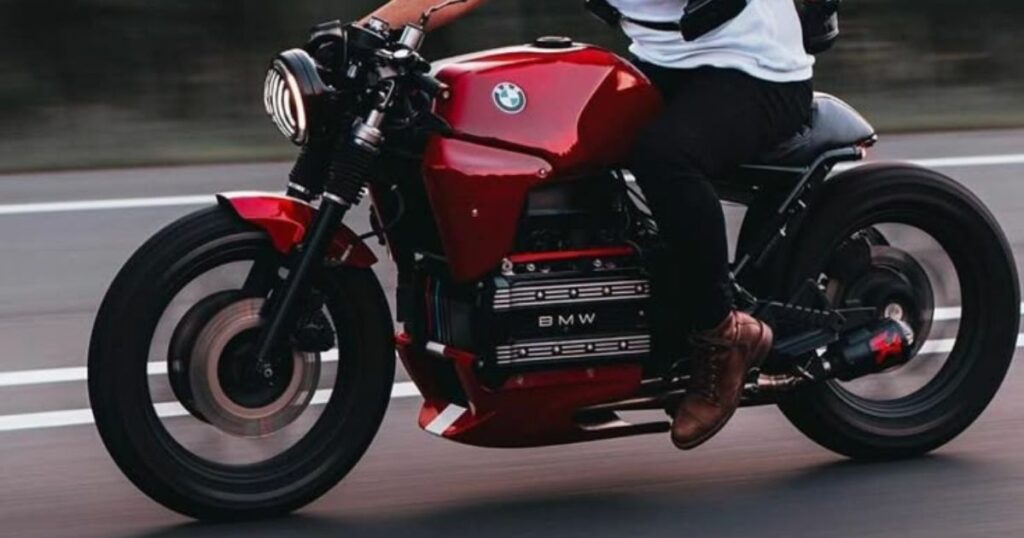
Engine Components
- Air Filters: Pod filters are popular because they’re simple and let more air in. K&N and UNI are brands people like.
- Exhaust Systems: Most people go for custom 4-into-1 or 4-into-2 systems. Stainless steel lasts a long time and sounds like a classic cafe racer.
- Fuel Systems: If your bike is older, you should switch to a newer fuel injection system. This can make your bike run better and be more reliable.
- Performance Tuning: Dynojet kits can help your engine get the right fuel and spark to make more power.
Chassis and Suspension
- Shock Absorbers: You can get special shocks from brands like Hagon or Öhlins that let you adjust how bouncy the ride is and how high the bike sits so you can customize it to feel just right for you.
- Forks: To improve the bike handle, you can upgrade to springs that get stiffer as they compress or add special parts inside the forks. You can also add fork covers for a classic cafe racer style.
- Frame Modifications: Some people shorten the back part of the frame and remove any extra pieces that stick out to give the bike a cleaner look.
- Triple Tree: Changing the triple tree (the part that holds the front forks) can adjust how the bike steers and handles and make it look more sporty.
Wheels and Tyres
- Wheels: You can pick wheels with spokes if you like a classic look or go with newer ones that are lighter and work well with sporty tires.
- Tires: Many riders choose sporty tires like Michelin Pilot Road or Pirelli Diablo Rosso because they help the bike grip the road and handle well.
Braking Systems
- Brake Pads: People often upgrade to EBC HH Sintered pads to strengthen their brakes.
- Brake Discs: You can get special wave rotors that look cool and help your brakes stay cooler.
- Master Cylinders: Getting a better master cylinder from Brembo or Nissin can make your brakes feel better and easier to control.
- Brake Lines: Braided steel brake lines feel firmer and don’t stretch as much when you use your brakes.
Electronics and Lighting
- Battery Options: Lithium-ion batteries are lighter and offer better-starting performance. You can get a lighter battery that helps your bike start better. [Check our blog: How to choose the best cafe racer battery]
- Wiring Harness: Cleaning up the wires makes the bike look nicer and lighter. Moto gadget’s m-Unit is a popular choice.
- LED Lights and Indicators: Switching to LED lights makes your bike look modern and easier to see. You can get new headlights, taillights, and turn signals.
Additional Components to Consider:
- Clip-on Handlebars: These lower handlebars help you lean forward like a racer.
- Custom Seat: A thin, one-person seat with a cover (the “cowl”) at the back.
- Rearsets: These move the footrests up and back for a sporty feel.
- Speedometer and Tachometer: The dials that show your speed and engine revs. Pick old-style ones or new digital ones.
- Bar-End Mirrors: Small mirrors on the ends of your handlebars look sleeker than big ones.
Remember, building a cafe racer is a personal journey. Choose the parts and components that best reflect your style and riding preferences.
How to Create Your Dream BMW K100 Cafe Racer?
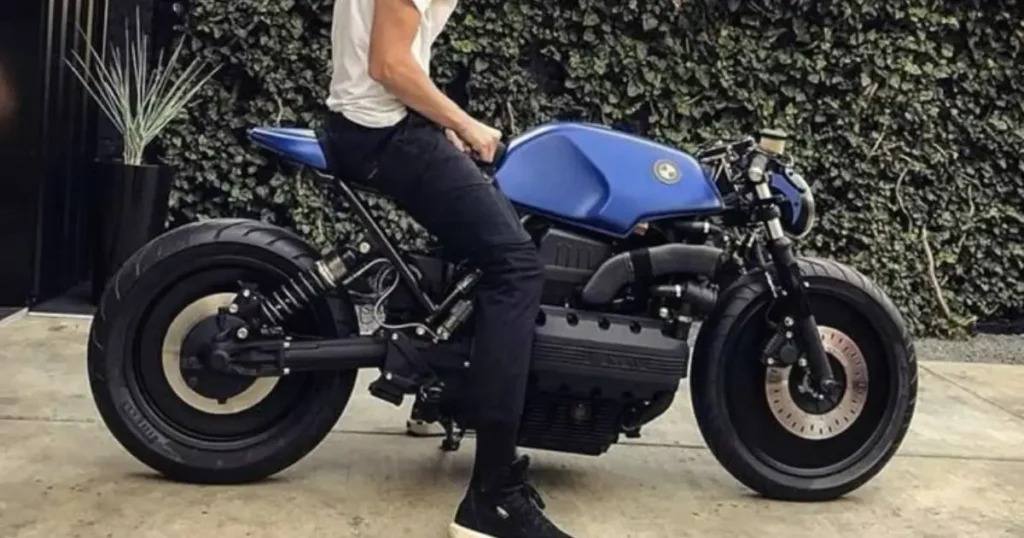
The BMW K100 nicknamed the “Flying Brick,” is becoming a favorite for custom cafe racer builds. Its strong engine, special frame, and unique look make it a great base for a cool, personalized motorcycle. Making Your Cafe Racer Building a cafe racer is more than just adding new parts. It’s about using your skills and imagination to create a bike that shows your love for motorcycles. Here’s what you need to do:
- Plan Your Design:
- Decide what you want your bike to look like. Get ideas from other cafe racers.
- Make a step-by-step plan for how to build your bike.
- Take Apart Your Bike:
- Carefully take apart your K100. Keep all the parts organized and labeled.
- Change the Frame:
- Adjust or change the back part of the frame to get the classic cafe racer look.
- Upgrade the Engine and Parts:
- Check the engine and other parts. Fix or improve them if needed.
- Choose New Parts:
- Pick out handlebars, a seat, lights, exhaust pipes, and other parts that match your design.
- Rewire the Bike:
- Make the wiring simpler and neater for a cleaner look.
- Put It All Together:
- Put your bike back together carefully. Add your special touches to make it unique. Things to Keep in Mind Building a cafe racer can be tricky. Here are some things to think about:
You might need skills like welding and electrical work.
Cafe racer builds can be expensive. Make a budget and stick to it.
Make sure your changes follow the rules for motorcycle safety. The Fun Part Building your cafe racer is a lot of fun! You’ll learn new things, be creative, and end up with a motorcycle that’s yours.
Ready to Start? I’m here to help you with step-by-step guides for each part of your build. Let’s build your dream BMW K100 cafe racer together!

Notable BMW K100 Cafe Racer Builds
Featured Builds:
Retrorides’ BMW K100 Cafe Racer: This motorcycle is a beautiful example of simple design. It has a cool fuel tank made of a special material called carbon fiber and a smooth back end. It looks just like the classic, cool cafe racer motorcycle.

Further North Fab’s BMW K100 Cafe Racer: This motorcycle is a new way of looking at the cafe racer style. It has sharp lines, better suspension, and a special paint job. It shows how much you can change a K100 motorcycle to make it your own.

Impuls’ BMW K100 Cafe Racer: This motorcycle goes beyond the usual cafe racer look. It has a futuristic style, special body parts, and lights that use new LED technology.

What are the essential maintenance tasks for your BMW K100 Cafe Racer?
Your BMW K100 Cafe Racer is a cool mix of old-school style and new-school power. You need to take care of it regularly to keep it running well and looking good. This guide will show you the important things to do so your cafe racer stays fun and safe to ride for a long time.
The Important Stuff
- Taking Care of the Engine: The engine is the heart of your bike. It needs clean oil, new filters, and good spark plugs to keep running smoothly. [Click to know common BMW K100 cafe racer engine problems and fixing]
- Checking the Gears and Chain (or Belt): These parts help get the power from the engine to the wheel. Make sure they have enough oil and aren’t too loose or too tight.
- Keeping the Brakes and Suspension Working: These keep you safe and help you ride smoothly. Check the brake pads and the special oil for the brakes. Make sure the suspension feels right for how you ride. [Learn more: BMW K100 Cafe Racer Brake Problems & Solutions]
- Looking After the Electrical Stuff: The battery, lights, and other electrical parts need to be in good shape. Charge the battery, check the little fuses, and make sure the wires aren’t broken.
- Keeping Your Bike Looking Good: Your cafe racer is special. Keep it clean, shiny, and protected from the weather. Explore our [guide on keeping your BMW K100 Cafe Racer clean] for expert tips and techniques.
Other Tips
- Look at Your Bike Often: Get to know it well. If you see something that doesn’t look right, you can fix it before it gets worse.
- Store It Right: When you’re not riding, keep your bike safe from rain and bad weather. You can use a cover to keep it clean.
- Use Good Parts: Use parts made by BMW or other good brands. This will help your bike last longer.
If you do these things, your BMW K100 Cafe Racer will always be a great bike to ride!
Making Your BMW K100 Cafe Racer Legal and Safe: What You Need to Know?
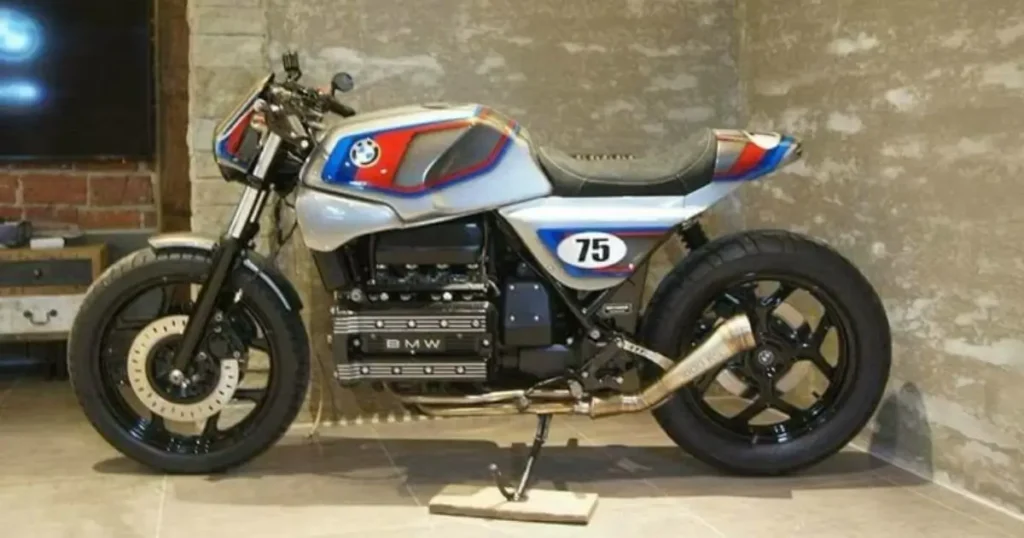
Rules for Changing Your Bike
Turning your BMW K100 into a cafe racer is awesome, but it’s important to follow the rules. Different places have different rules for changed motorcycles.
- United States: Each state has its own rules. Check with your state’s DMV to make sure your cafe racer is okay to ride on the road. This might mean getting it checked for safety, registering it, and making sure it doesn’t pollute too much.
- United Kingdom: You can usually change your bike, but it needs to pass a special test called the MOT. Make sure all the new parts you add are safe for the road and follow the rules.
- European Union: Each country in the EU might have slightly different rules. Make sure your motorcycle follows the rules in your country and gets approved if you make big changes.
- Australia: Your motorcycle needs to follow the Australian Design Rules. Each state also has its own rules, so check with your local transport office.
Keeping the Air Clean
In many places, your cafe racer needs to follow rules to help keep the air clean. Here’s what you need to know:
- Check the Rules: Find out what the rules are in your area for how much pollution a motorcycle can make.
- Special Part: You might need to add a part called a catalytic converter to your motorcycle. This part helps to reduce the bad stuff in the exhaust.
- Exhaust System: If you change the exhaust, make sure it isn’t too loud and still follows the pollution rules.
- Inspections: Be ready to take your motorcycle to get checked to make sure it’s still okay for the road and not causing too much pollution.
Safety Gear
Staying safe while riding your custom BMW K100 cafe racer is super important. Wearing good safety gear can help if you get into an accident. Here’s what you need:

- Helmet: Always wear a helmet that has been approved for safety. It should protect your head in case you fall. Full-face helmets are the safest.
- Jacket and gloves: Wear a strong jacket made of leather or something tough. It will protect your skin if you slide on the road. Wear gloves that protect your hands but still let you hold on to the bike’s handles.
- Riding boots: Get boots that protect your feet and ankles. They should have strong toes and good grips on the bottom to help you stand on the bike’s pegs.
By following the rules and wearing safety gear, you can have a safer and more fun time riding your custom BMW K100 cafe racer
What Are the Upcoming Trends in Cafe Racer Design?
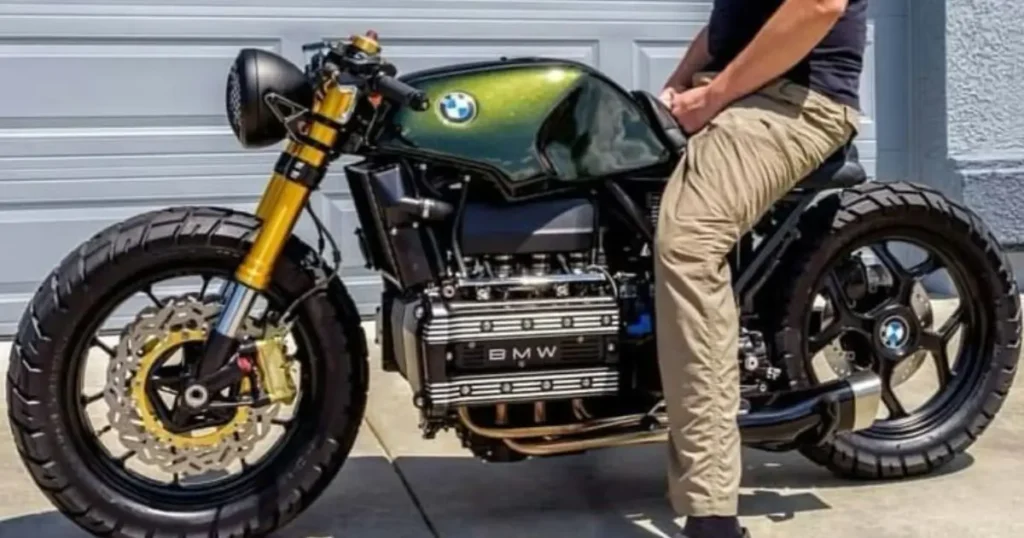
Cafe Racers Are Changing: What’s Next?
Get ready because cafe racers are getting a major makeover! 3D printing lets people create unique parts, and builders use carbon fibre and titanium to make bikes lighter and stronger.
We’re seeing high-tech upgrades like intelligent dashboards with GPS and Bluetooth. Some bikes are even going electric! Imagine a silent cafe racer that still looks amazing.
The look of cafe racers is changing, too. Some builders are combining the classic style with modern lines and futuristic details. Others are going for a retro-futuristic or even steampunk vibe. There’s a trend toward keeping things simple and practical, where every part has a purpose.
But one thing’s for sure more and more people are loving cafe racers! Demand for custom bikes is growing, and younger riders are joining the scene. It’s a way for them to be creative and show off their personality.
The future of cafe racers will be shaped by a few things. People care more about the environment. Expect to see more sustainable materials and electric options. Rules about pollution and noise are also pushing the industry towards greener choices.








Plus, online communities are bringing cafe racer fans from all over the world together, and that’s sure to spark even more creativity and innovation.
It’s exciting to think about what cafe racers will look like in the future. One thing’s clear: this motorcycle style isn’t going anywhere. It’s a unique mix of history, performance, and personal touch that keeps riders coming back for more.
Conclusion
The BMW K100 Cafe Racer is a special motorcycle. People love making their motorcycles unique. It has a classic cafe racer look and smart BMW engineering. It also has a group of lively fans. It started as a bike for long trips. Now, people change it to make it their own. Riders all over the world love it.
As technology improves and we care more about the environment, cafe racers will change. They will have new designs and materials. They will also work better. The K100 is a strong bike. It will stay popular. People will keep using it to build their dream motorcycles. You might like its history, the chance to make it your own, or just riding a special bike. The BMW K100 Cafe Racer has a lasting story and a bright future.
FAQs
What makes the BMW K100 a good cafe racer?
The K100 has a strong frame and a powerful engine. Its design makes it great for building a cafe racer that looks cool and runs well.
How much does it cost to customize a BMW K100?
The cost depends on the changes. A BMW K100 cafe racer can cost between $3,000 and $10,000, including parts and labor.
Can I customize a BMW K100 myself?
Yes, you can do basic changes like swapping seats. But for big jobs, like welding, it’s safer to hire a pro.
Are there legal restrictions for customizing the K100?
Yes, laws may limit exhaust changes, lights, and safety features. Check local rules, as they vary by country or state.
What are the common BMW K100 cafe racer mods?
Popular mods include new seats, lower handlebars, custom exhausts, better suspension, and simple bodywork.
What is the “Flying Brick” engine?
The “Flying Brick” is the K100’s inline-four engine. It’s tough, lasts a long time, and has a flat, boxy shape.
Can I use a BMW K100 cafe racer for long trips?
Yes, though cafe racers are best for short rides. For long trips, adding seat padding and better suspension helps with comfort.
What are some iconic BMW K100 cafe racer builds?
Famous builds come from shops like Moto Rebuild and K-Speed. These are known for clean designs and pushing cafe racer limits.
How do I maintain my BMW K100 cafe racer?
Change the oil, check the cooling system, and maintain the suspension. Keep it clean and in tune to ensure it runs well.
Where can I find parts for my BMW K100 cafe racer?
You can buy parts from BMW dealers, online marketplaces like eBay, or shops that specialize in vintage bikes.

